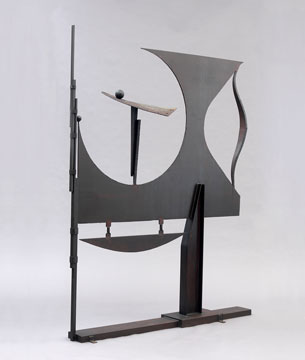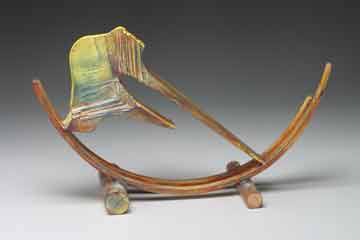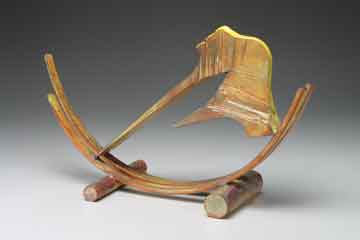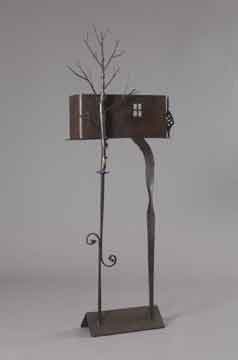

| For more information about this article or gallery, please call the gallery phone number listed in the last line of the article, "For more info..." |
December Issue 2007
Hickory Museum of Art in Hickory, NC, Features Retrospective Exhibit for Bill Brown
 The
Hickory Museum of Art in Hickory, NC, is offering The Art of
Transformation, featuring a retrospective of works by Bill
Brown on view from Dec. 8 - Mar. 9, 2008. The retrospective features
a large body of work shown together for the first time. Included
are several of Brown's floor and table lamps, which combine blown
glass and various metals.
The
Hickory Museum of Art in Hickory, NC, is offering The Art of
Transformation, featuring a retrospective of works by Bill
Brown on view from Dec. 8 - Mar. 9, 2008. The retrospective features
a large body of work shown together for the first time. Included
are several of Brown's floor and table lamps, which combine blown
glass and various metals.
For millions of years, the clean mountain water of the Linville River has pounded relentlessly over the falls and into the solid granite basin of Linville Gorge, reshaping the land, pushing and carving a path toward the sea.
Nearby, in a tall metal building, Bill Brown's air hammers thump out with a similar brutal, deafening force. Here, equipped with the tools of a blacksmith and sculptor, Brown creates sculpture that resounds with a monolithic, primal presence.
For those who have visited North Carolina's High Country, there is often a feeling of comforting enclosure, of safety; the high grassy hills and fragrant vegetation create an unavoidable connectedness to nature. In this environment Brown has honed a deep understanding of the elemental, literally forging the physical manifestation of his creative vision.
Brown's pieces are simultaneously solid and lyrical; the metal often seems to defy gravity, carefully balanced arms reaching skyward. Reminiscent of Japanese calligraphy, the work dots the landscape around his studio. Some pieces possess an intimate, human scale others are massive and permanent, like the large boulders that line the gorge. Still others have the quality of mystery of an old rusted farm implement pulled from the dirt, its specific use forgotten.
Although Brown sometimes starts with a sketch, he enjoys "working hot" in his studio, hammering, molding, and manipulating the hot steel as it moves from furnace to anvil and back again. Brown speaks of an inner calm that he strives to find and observes that his most successful work comes when, "I can get out of my own way."




Wishing not to force the piece, but to allow it to come forth with its own energy and dynamism, Brown guides the material toward the end result. Trusting his own instincts, he uses tools both archaic and hi-tech to push the malleability of the material, which he likens to potter's clay. About 8 years ago he began adding surface color in the form of oil and wax on exterior pieces, and acrylic paint on smaller interior work.
The Arts have played an integral role in Brown's life since childhood. His father was director of the renowned Penland School. There Brown spent time observing the master artists at work as well as washing dishes and working other odd jobs around the campus. He was soon to become the first resident ironworker at the school.
Citing the influence of the Japanese sculptor Isamu Noguchi, Brown's work is a spiritual exercise as well as a physical one. In the same way that Noguchi created abstract forms that enlivened and animated public gardens and plazas, so Brown's work leaves proof of his ideas, bringing the unknown and amorphous into reality, and enriching the environment in which it resides.
For further information check our NC Institutional
Gallery listings, call the Museum at 828/327-8576 or visit (www.hickorymuseumofart.org).
Carolina Arts is published monthly by Shoestring Publishing
Company, a subsidiary of PSMG, Inc.
Copyright© 2007 by PSMG, Inc., which published Charleston
Arts from July 1987 - Dec. 1994 and South Carolina Arts
from Jan. 1995 - Dec. 1996. It also publishes Carolina Arts
Online, Copyright© 2007 by PSMG, Inc. All rights reserved
by PSMG, Inc. or by the authors of articles. Reproduction or use
without written permission is strictly prohibited. Carolina
Arts is available throughout North & South Carolina.